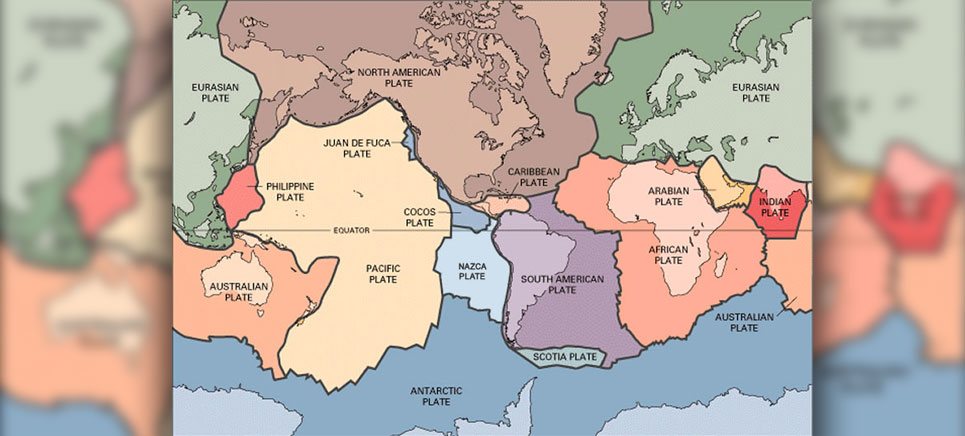The lithosphere of the earth, which includes the crust and the upper-mantle is composed of numerous tectonic plates. These plates fit together like a giant jigsaw puzzle. The tectonic plates are floating over the layer of liquid rock and hence they move slowly over time. This movement of the plates causes the edges of the plates to interact with each other. These interactions between the plate tectonics are very important geomorphological phenomenon as they are associated with earthquakes, volcanoes, formation of mountains etc.
Definition and Types of Plate Tectonics Boundaries
The edges of the plate tectonics are called their boundaries and they are classified based on their interaction with the neighboring plate boundaries. The tectonic plate boundaries are broadly classified into three categories – Convergent Boundaries, Divergent Boundaries and Transform Boundaries.
- Convergent Boundaries – Two plates may float towards each other. These plates that come together form a convergent boundary.
- Divergent Boundaries – When two plates move away from each other, they form a divergent boundary.
- Transform Boundaries – When two plates slide past each other, they form a transform boundary.

Comparing Different Kinds of Plate Boundaries
| Basis of Comparison | Convergent Boundaries | Divergent Boundaries | Transform Boundaries |
|---|---|---|---|
| Movement | Plate boundaries move towards each other. | Plate boundaries move apart from one another. | Plate boundaries slide past each other horizontally. |
| Effect | Lithosphere can be destroyed due to the collision. This is the reason convergent boundaries are also called a destructive plate boundary. | When plates move apart molten rocks from the asthenosphere come up and cools down to form the new lithosphere. This is the reason divergent boundaries are also called a constructive plate boundary. | The transform boundaries results in no creation or destruction of the earth’s crust hence they are also called a conservative plate boundary. |
| Examples | Himalayas; Aleutian Islands | Mid-Atlantic Ridge; Pacific Ring of Fire | San Andreas Fault Zone |
| Geomorphological Events |
|
Earthquakes occurring in these zones are relatively small. | Plates while sliding past each other form fault or fracture on the earth’s crust. |
Frequently Asked Questions
Question: What plate tectonic boundaries do earthquakes occur at?
Answer: 80 % of the earthquakes occur at the convergent plate boundaries where two tectonic plates collide with each other.
Question: What tectonic plate boundaries do volcanoes occur?
Answer: Volcanoes occur at both divergent and convergent plate boundaries. Volcanoes occurring at convergent margins generally are explosive and they form stratovolcanoes while volcanoes at the divergent plate margins are usually more effusive and hence forms shield volcanoes.
Question: What tectonic plate boundary forms mountains?
Answer: Typically, convergent plate boundaries results in the formation of big mountain ranges. This happens when two continental plates collide. Continental plates have similar density hence none will sink beneath the other. So, both the plates crumple and fold to form mountains.
Question: Which tectonic plate boundary is the most dangerous?
Answer: Since greater earthquakes and larger volcanic activities happen on the margins of convergent plates, convergent plate boundaries can be considered as the most dangerous tectonic plate boundary.
Question: Who identified the plate tectonic boundaries first?
Answer: Alfred Wegener, a meteorologist, was the first person to describe a natural phenomenon which he termed as continental drift. The idea developed by him formed the basis of the modern theory of plate tectonics.
Use the citation below to add this article to your bibliography
"Plate Tectonic Boundaries: Definition, Types and Examples." Dashamlav.com. Web. 27 July 2024. <https://dashamlav.com/plate-tectonic-boundaries-definition-types-and-examples/>
Dashamlav.com, "Plate Tectonic Boundaries: Definition, Types and Examples." Accessed 27 July 2024. https://dashamlav.com/plate-tectonic-boundaries-definition-types-and-examples/
"Plate Tectonic Boundaries: Definition, Types and Examples." (n.d.). Dashamlav.com. Retrieved 27 July 2024 from https://dashamlav.com/plate-tectonic-boundaries-definition-types-and-examples/
